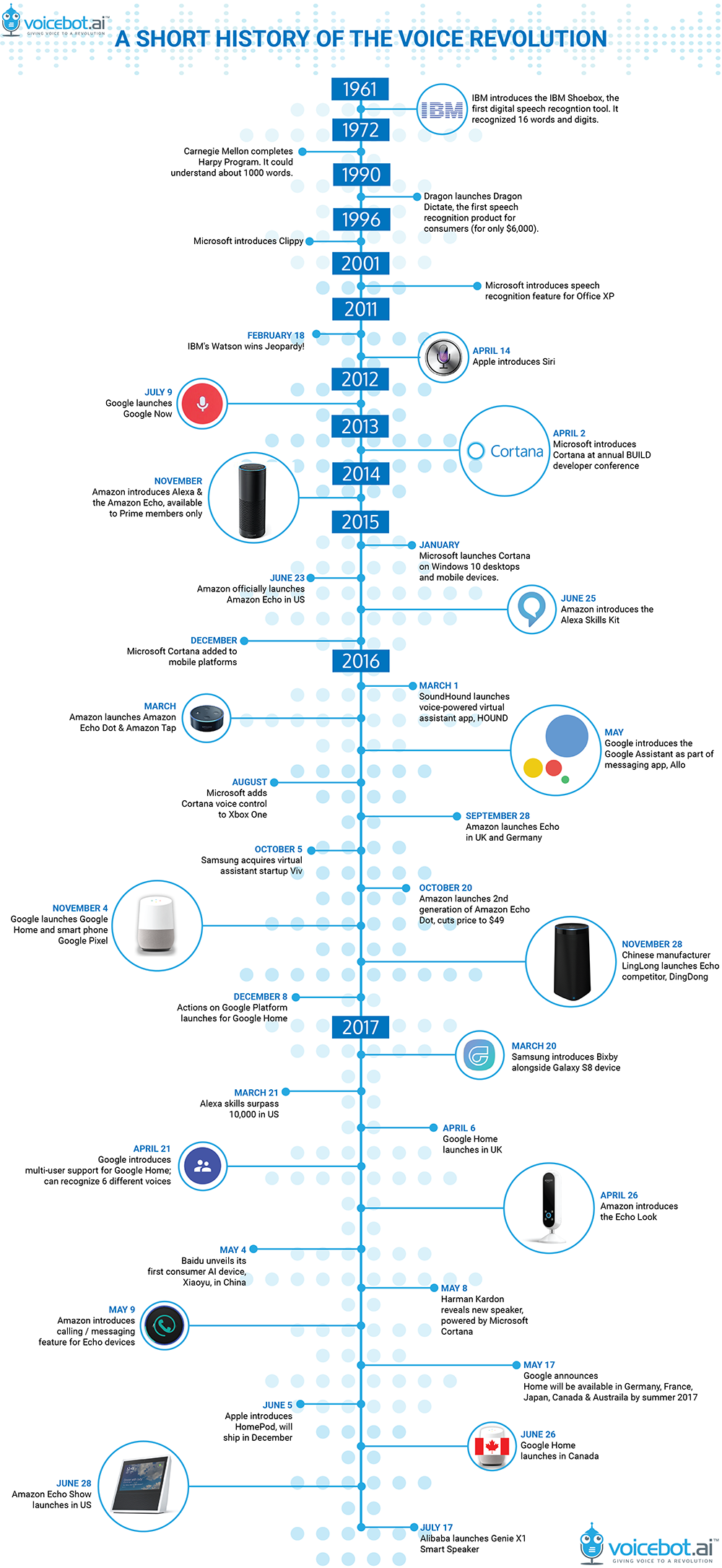Voice technology: The voice heard ‘round the world. We’ve all heard of Amazon’s Alexa and Google Assistant (maybe even Samsung's Bixby and Alibaba’s Tmall Genie).
As I mentioned in my last monthly column, one of the exciting new frontiers of technology is the shifting ways we interact with it. Voice technology in particular has played a huge role in these changes. Welcome to the multimodal age, where voice technology and natural language processing (NLP) rule supreme.
The rise and rise of voice tech
Voice technology or voice recognition, along with the internet of things (IoT) is so ubiquitios that we tend to forget that it hasn't always been a part of our lives.
| RELATED: Learn more about the inner workings of voice recognition. |
 Soure: voicebot.ai
Soure: voicebot.ai
Voice assistants aren’t going anywhere. If anything, they seem to have more use cases every day. What does adoption of these voice assistants look like on the ground? How is the technology used, and how are companies leveraging it to reach users or potential customers?
One thing is for sure: Voice is on the rise. As of Q1 2019, over 31% of households in the United States owned a smart speaker with an intelligent personal assistant. (Compare that to the 8% who owned one in 2016.) The United Kingdom is not too far behind. New data from Strategy Analytics showed that through June 2019, about 20% of households in the United Kingdom have a smart speaker.
Smart speaker ownership is only a partial predictor for the prevalence of voice technology. Including mobile phone usage, Location World discovered that about 40% of adults use voice search at least once a day.
| RELATED: Check out these 43 voice search statistics for 2019 → |
According to eMarketer, 31 million Americans will shop using a smart speaker this year. Since customers have the ability to order groceries via Google Assistant, and just about anything from Amazon via Alexa, it’s likely that more customers will utilize voice tech in the near future. From a business perspective, the opportunity for increased revenue from voice tech is exciting.
The bottom line: Voice is spreading, so brands must leverage and include it as part of their broader digital strategy. Below, we will focus on the e-commerce side of things, but will explore other far-reaching industry applications in later columns.
Why is this happening?
To understand why voice tech was embraced so quickly, it’s worth looking back on the evolution of the human-computer relationship that’s developed in technology itself, as well as the user experience (UX).
Many complex technologies such as AR, VR, IoT, and gesture control are tapping into the need for natural user interfaces. We’ve been on a journey toward this naturalization of the human-computer relationship for a long time.
We are moving toward more user-friendly, intuitive interfaces. Whether it be with switches, keyboards, or touchscreens, we are communicating with our technology in more natural ways. Voice, facilitated by speech recognition tech (like Google’s that has 95% accuracy), is the next frontier.
At the same time, user experience criteria has evolved. When developing technologies, developers used to focus on criteria such as reliability, accuracy, and speed. Fast forward to today, where we’re focusing on and talking about technology that we can trust, build relationships with, and find comfort in. This evolution in the personification of technology is key to the new form of user experience. It’s important to note that previous expectations haven't gone away. We still expect our tech to be fast and reliable; we now want it to do that in a way that feels both organic and bespoke—it is called natural language processing (NLP), after all.
Voice makes technology feel more human and allows people to trust it more. Voice will prove to be an important natural interface that mediates our communication and relationships with our devices, and ultimately, our communication and relationships within an AI-powered world.
Speaking naturally with voice technology
What are the characteristics of voice that make it such a natural interface?
-
- Speed: Homo sapiens speak an average of 150 words a minute and type an average of 40 words a minute. When we speak, there is no process translating the voice in our head to referential buttons on a keyboard or phone.
- Liberating: In a world where technology is supposed to free us, the development of visual screens on phones and tablets have constrained us, forcing our heads down. Voice brings our heads back up, liberating us from fixation on a screen and allowing the ability to multitask and interact with our technologies at the same time. With voice, we can seamlessly multitask since it’s already a natural part of our environment.
- Primal: We have been able to speak for as long as we can remember. Voice is registered in the most primitive parts of our brain; therefore, voice is not as heavy on our brain compared with other forms of communication.
Individuals’ interactions with computers, television, and new media are fundamentally social and natural, just like interactions in real life, according to "The Media Equation" by Reeves and Nass.
Quer aprender mais sobre Software de Reconhecimento de Voz? Explore os produtos de Reconhecimento de Voz.
What value does voice offer brands?
How can brands use this new interface to their benefit? There are several aspects of voice that companies should consider as they start their voice journey.
-
Creating a digital personality
Voice tech gives brands the ability to discover their unique sound and develop a digital personality to create meaningful and fluid brand moments, breeding brand loyalty with their customers. For example, Just Eat, a British online food order and delivery service, has done this well with humorous responses such as, “You’ve ordered like a bawse (boss)!” and “Okie dokie buddy.” While that may seem pretty basic, it can go a long way in humanizing the interaction a customer has with that brand. -
Generating awareness
Brands can use voice to increase their discoverability and generate brand awareness by designing a voice experience that provides utility. For example, Tide developed a voice app on Alexa that users can converse with to get help removing different types of stains. Leveraging voice tech to provide utility to consumers helps Tide implant an association between its brand and its product objectives (speedy stain removal). -
Facilitating transactions
A brand that develops a voice experience that facilitates the purchasing process will provide a purchasing experience that reduces friction for the user, resulting in customer loyalty. A great example is the Ocado Alexa skill. This skill assists in the purchasing of groceries while giving users a fantastic voice tech experience. Domino’s is another great example, providing customers with an Amazon Alexa skill that makes it easy to quickly order pizza. -
Personalizing the interaction
Brands can tailor voice interactions to the needs and desires of their consumers to develop a trust halo. For example, American Express has an Alexa skill that provides data and information, such as spending patterns, tailored to the customer in question.
| RELATED: Learn four ways to listen to the voice of the customer and improve customer experience, here → |
Now what?
As far as we have seen, end users expect brands to be available via voice technology. With this reality in mind, SaaS companies must bridge the gap, and provide users with tools to succeed.
Several trends we’ve recently seen in this direction include:
- Voice search as a service: Algolia, which raised $110 million last month, wants to make a big push in the direction of voice. Both the CEO and cofounder said the company wants to “enrich [its] conversational and voice search capabilities across web, mobile and voice-first channels to meet increasing consumer demand to search any way, any where, any time.”
- Drag-and-drop tools to build voice apps: In April, Voiceflow, which allows anyone to make voice apps without coding, raised $3.5 million.
-
- Voice-enabled websites: At the end of July, Airbud raised $4 million. This technology will allow users to easily add a voice interface to their website.
Talkin’ ‘bout those limitations
Although the picture we’ve painted is accurate, the brush strokes are broad and the color is limited.
In the second part of this series, we will have a look at the limitations of voice technology across industries, including privacy concerns, the future of voice commerce, and more.
Stay tuned.

Matthew Miller
Matthew Miller is a research and data enthusiast with a knack for understanding and conveying market trends effectively. With experience in journalism, education, and AI, he has honed his skills in various industries. Currently a Senior Research Analyst at G2, Matthew focuses on AI, automation, and analytics, providing insights and conducting research for vendors in these fields. He has a strong background in linguistics, having worked as a Hebrew and Yiddish Translator and an Expert Hebrew Linguist, and has co-founded VAICE, a non-profit voice tech consultancy firm.
